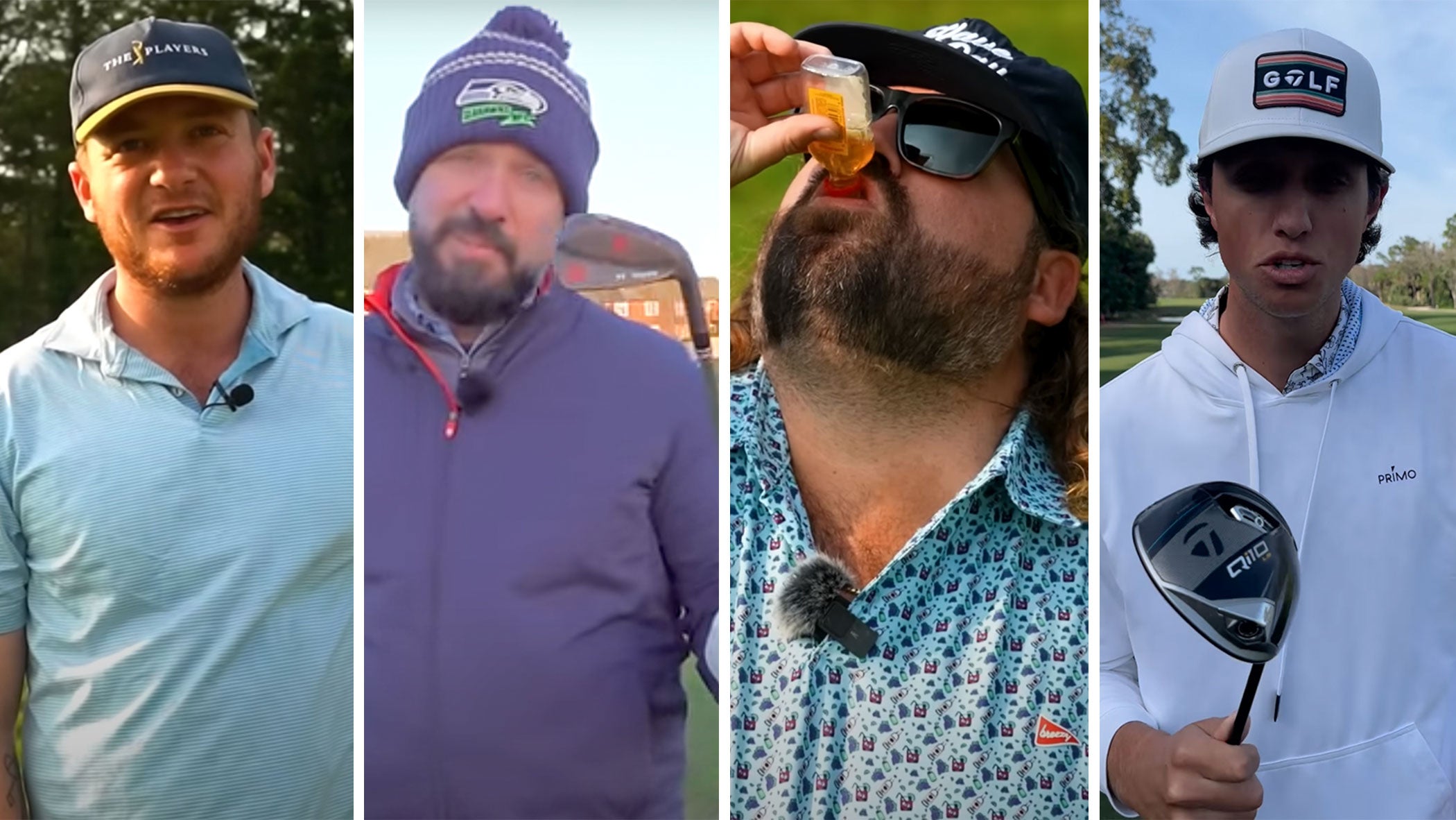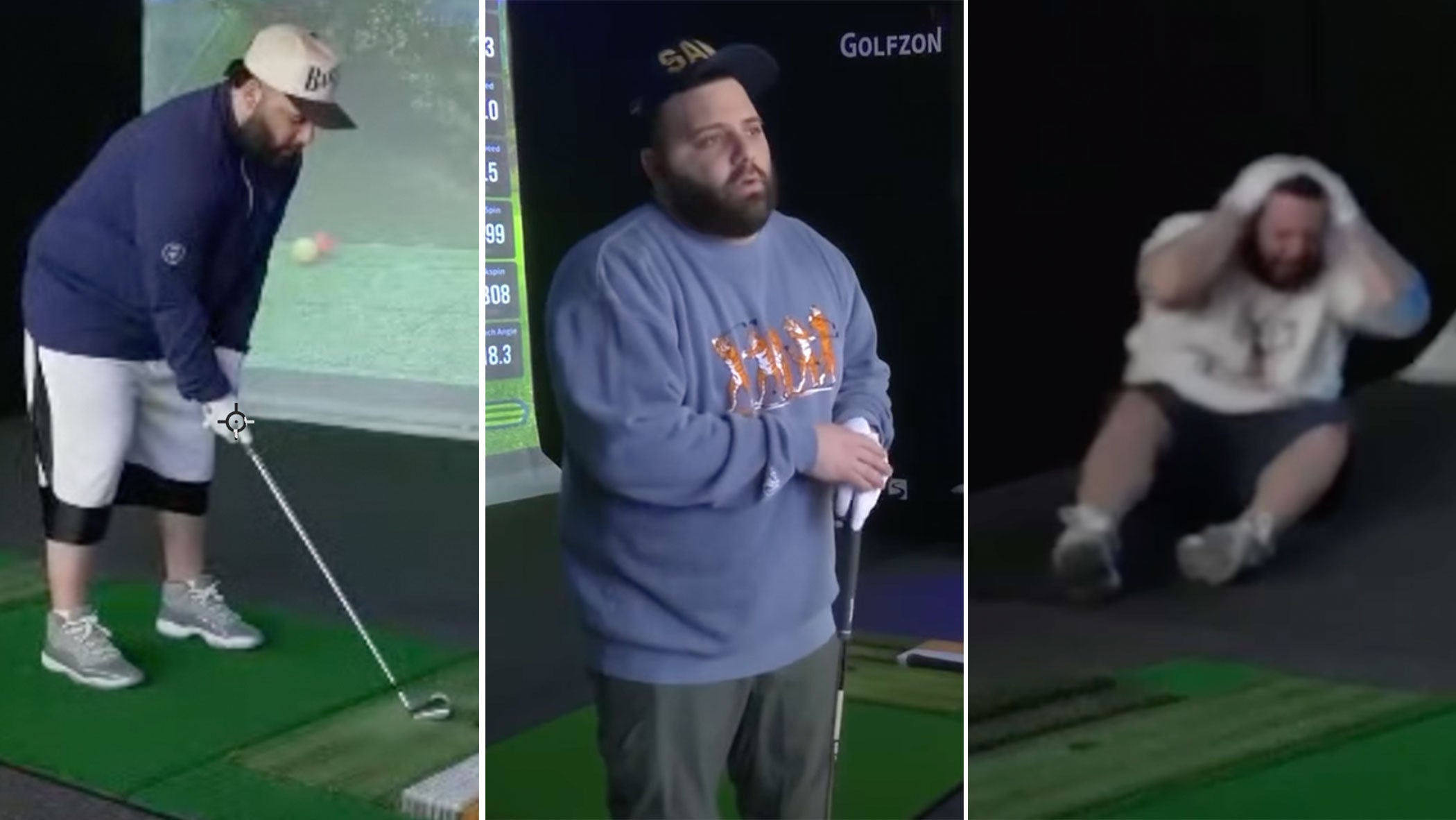
Among the participants in a PGA Tour qualifier held earlier this week was, from left, Dan Rapaport, Peter Finch, Fat Perez and Grant Horvat.
If you missed the results from the 18-hole PGA Tour qualifier in Myrtle Beach, S.C., earlier this week, that was by design. Not only are the scores unavailable, the event’s 16 participants are, for the better part of the next two months, contractually prohibited from talking, tweeting or in any other way disseminating information about how they fared.
Wilder still, half of the field was comprised of golf-obsessed podcasters, personalities and influencers with massive YouTube, TikTok and Instagram followings. Publicly crowing about their golf pursuits is literally their jobs, and yet after competing in arguably the biggest event of their careers, a first-of-its-kind competition that awarded the winner a spot in the PGA Tour’s Myrtle Beach Classic in May? Yep, crickets.
“It is kind of an interesting social experiment,” Dan Rapaport, a Barstool Sports personality who played in the event, told me by phone. “It’s, like, get people who what they do for a living is talk about themselves and golf, have them play in this big event, hype it up and then everyone just goes silent for two months.”
The formal name of the event is The Q at Myrtle Beach, and it was conducted Monday at TPC Myrtle Beach, a challenging Tom Fazio-Lanny Wadkins design that lacks for neither sand nor water. That one of the influencers triumphed is far from a certainty — in fact, odds are one didn’t — because the other half of the field was filled out by pros, including the likes of 2021 NCAA Div. 1 champion and former LIV golfer Turk Pettit and Korn Ferry winner Matt Atkins. The YouTubers are no hacks — each was handpicked to play in part because they maintain handicaps of scratch or better — but still, when it comes to posting a score in the heat of competition, there is a wide chasm between most elite amateurs and pros.
However you feel about a pack of content creators being handed an opportunity to vie for a PGA Tour start, it’s hard to dispute that the event wasn’t an inventive marketing tool for a rookie Tour event. Or at least it will be when the golf world finally learns how the qualifier played out. That reveal won’t happen until April 23 by way of a 90-minute recap video on Play Golf Myrtle Beach’s YouTube page, soon after which the influencers will be permitted to publish and promote their own content about their experience. In other words, if you subscribe to or follow the likes of Fore Play, Good Good or Bob Does Sports, come late April be prepared for a rush of video from the TPC Myrtle showdown.
For the Myrtle Beach Classic, which will be contested May 9-12 at Dunes Golf and Beach Club (the same week as the loaded-field Wells Fargo Championship), that will mean a publicity boon — and getting in front of audiences that might not be regular PGA Tour watchers. And sizable audiences at that. Among the YouTubers in the field was Grant Horvat, who played on the golf team at Palm Beach Atlantic University and has more than 1.35 million combined subscribers and followers on his social feeds; Peter Finch, a UK-based YouTuber with more than 1.25 million subscribers and followers; and Luke Kwon, a Good Good member who has made 50 starts on PGA Tour-sanctioned tours and has a social following of nearly 400,000. (Good Good’s YouTube page has another 1.4 million subscribers.) All in, that’s a lot of eyeballs.
“We realize where we are on the PGA Tour schedule so anything we can do to shine a light on the Myrtle Beach Classic, we are certainly open to,” said Darren Nelson, the event’s tournament director. “The [qualifying] concept is one of a kind, and honestly we kind of hope it stays that way. We’ve had some other PGA Tour events reach out to our team, like, ‘Man, I wish I would have thought of that.’ So that tells you right there that we’re onto something that’s unique and different and that people are noticing.”
To prevent the awkward lag between the event’s conclusion and the disclosure of its winner, could the qualifier not have been aired live? It could have, sure, but that would have been much more costly and also resulted in a different kind of production than what tends to resonate on YouTube.
“By basically shooting it as a YouTube video, which is what they did, they take cameras out there and we were wearing mics,” Rapaport said. “It’s kind of the same thing that we do normally when we film golf rounds, and it gives them to chance to distill it down to the best bits and make a really compelling piece of content as opposed to just people seeing how the qualifier played out by players making scores.”
To prevent any scoring leaks, tournament organizers required each of the competitors to sign non-disclosure agreements. Rapaport, for one, said he’s committed to keeping up his end of the bargain. “We had a Barstool Classic event yesterday, and I was asked the question a hundred times,” he said of what he posted at TPC Myrtle. “I just kept on saying somewhere between 64 and 80.”
He added: “We’re all humans here. You’re going to tell your wife how you played or even your podcast cohost how it went. I think they just don’t want someone to go on a podcast and say, ‘Here’s who won. Here’s how I played. Here’s how everyone played.’ I think people realize that a rising tide lifts all ships when it comes to YouTube golf or influencer golf, and so I think everyone’s on board with playing by the rules. We signed up for this thing knowing that we weren’t going to be able to talk about it, and someone going out there on his podcast or YouTube channel and saying I shot this, this or this, it just ruins it for everyone.”
Rapaport said the course setup was difficult, with thick rough and tucked pins, which caught him off guard. “I was sort of expecting that they were going to set it up easy, because they wanted to avoid the perception that these guys [the influencers] all stink and you’re not worthy of a spot in a qualifier for a PGA Tour event.”
Nelson, the tournament director, said they were targeting a setup length of 6,950 yards, but he was unsure if any tees were moved up to account for wind. “The idea was to be able to simulate what they’ll face over at the Dunes Club,” he said.
The field was sent off in four groups of four, with two influencers paired with two pros. No fans were permitted on property, but with the pros going about their business as they typically do and the YouTubers’ exuding nervous energy, Rapaport said “it felt like a big-time event.”
“Tournament golf is just a different beast,” he said. “You get comfortable playing on camera for YouTube, which is more stressful than playing by yourself. But then playing when you know there’s going to be a score — especially for an event like this when you know fans of YouTube golf are going to be comparing everyone’s scores, and knowing that you’re going to be judged at the end of the round, just changes your whole comportment on the golf course.”
Rapaport declined to say whether the qualifier was decided by a clutch putt or other heroics, or if there was any kind of post-round celebration of the champion on the 18th green. But he did say that toward the end it became clear who was going to prevail, and that the YouTubers were eager to compare their results with one another. “You want to shoot the lowest score,” he said.
And now? Well, now we wait to see what happened — which in our instant-gratification, information-flooded, social-media-driven world is not something to which sports fans are accustomed.
“There will definitely be a lot of content,” Rapaport said. “It’ll just be a matter of if we can keep it secret until then. I think we can. I have faith in us.”








